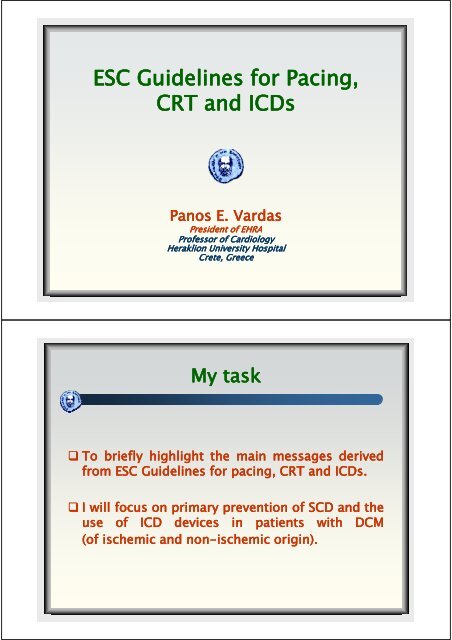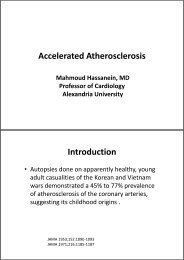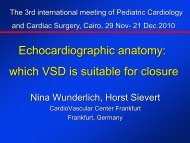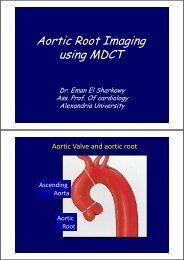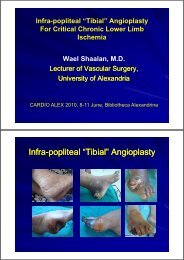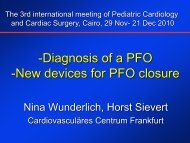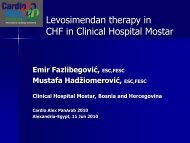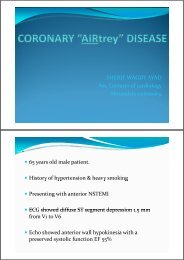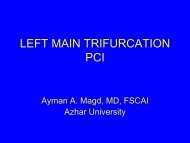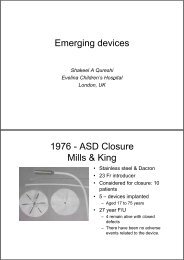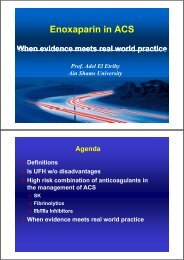ESC Guidelines for Pacing, g CRT and ICDs
ESC Guidelines for Pacing, g CRT and ICDs
ESC Guidelines for Pacing, g CRT and ICDs
- No tags were found...
Create successful ePaper yourself
Turn your PDF publications into a flip-book with our unique Google optimized e-Paper software.
<strong>ESC</strong>/EHRA <strong>Pacing</strong> <strong>Guidelines</strong> <strong>ESC</strong> guidelines cover two main areas: the firstincludes permanent pacing in bradyarrhythmias,syncope <strong>and</strong> other specific conditions, while thesecond refers to ventricular resynchronization asan adjunct therapy in patients with HF.<strong>ESC</strong>/EHRA pacing guidelinesAppendices Theguidelineshavebeenenrichedwithihtwoappendices that refer not only to conventionalpacemakerfollow-upbut alsototechnicalconsiderations <strong>and</strong> requirements <strong>for</strong> implanting<strong>and</strong> follow-upof <strong>CRT</strong> devices.
Sinus node diseaseRecommendations <strong>for</strong> cardiac pacing in SNDConventional indications <strong>for</strong> pacingThe <strong>ESC</strong>/EHRA 2007 <strong>Guidelines</strong> present detailed definitions follow anup-toto-datepatients with syncope.approachtotheevaluationof take into consideration the results of recent trials (MOST,CTOPP, PASE, DAVID etc) <strong>and</strong> the technological advances,providing• level of evidence in mode selection.• recommendations <strong>for</strong>theuseofnew algorithms(MPV,ANTITACHY)
Recommendations <strong>for</strong> cardiac pacingin carotid sinus syndromeRecommendations <strong>for</strong> cardiac pacing in VVS(<strong>ESC</strong>/EHRA 2007 GLs)
Conventional indications <strong>for</strong> pacingThe <strong>ESC</strong>/EHRA 2007 <strong>Guidelines</strong> present detailed definitions follow anup-toto-datepatients with syncope.approachtotheevaluationof take into consideration the results of recent trials (MOST,CTOPP, PASE, DAVID etc) <strong>and</strong> the technological advances,providing• level of evidence in mode selection.• recommendations <strong>for</strong>theuseofnew algorithms(MPV,ANTITACHY)Pacemaker mode selectionin sinus node disease
Cardiac Resynchronization TherapyThe <strong>ESC</strong>/EHRA 2007 GLs From atheoreticalpoint of view it may be moreappropriate to target mechanical dyssynchrony,rather than electrical conduction delay. However,theexistenceofmechanicaldyssynchrony in HF has not yet been establishedas a patient t selection ect criterion <strong>for</strong> <strong>CRT</strong>.Cardiac Resynchronization TherapyCriteria <strong>for</strong> patient selectionEchocardiographic criteria <strong>for</strong> <strong>CRT</strong>Ten years of research in the field of dyssynchrony inechocardiography have resulted in two negative studieswhich have, to some extent, discredited the method:PROSPECTRETHINQ
<strong>ESC</strong> / EHRA <strong>Guidelines</strong> <strong>for</strong> Cardiac <strong>Pacing</strong><strong>and</strong> dC Cardiac Resynchronization i Therapy<strong>ESC</strong> <strong>Guidelines</strong> <strong>for</strong> Cardiac <strong>Pacing</strong> <strong>and</strong> Resynchronization Therapy 2007 (EHJ 2007)Recommendation e o <strong>for</strong> the use of cardiac ac resynchronizationotherapy by <strong>CRT</strong>-P <strong>and</strong> <strong>CRT</strong>-D in HF patientsHeart failure patients, who remain symptomatic in NYHA classes III –IV, despite optimal medical therapy, with:• LVEF < 35 %• LV dilatation• QRS complex > 120 ms• Normal sinus rhythm• Class I, level of evidenceA<strong>for</strong><strong>CRT</strong>-P to reduce morbidity<strong>and</strong> mortality.<strong>CRT</strong>-D is an acceptable option <strong>for</strong> patients who haveexpectancy of survival > 1 year<strong>ESC</strong> / EHRA <strong>Guidelines</strong> <strong>for</strong> Cardiac pacing<strong>and</strong> dC Cardiac Resynchronization i Therapy<strong>ESC</strong> <strong>Guidelines</strong> <strong>for</strong> Cardiac <strong>Pacing</strong> <strong>and</strong> Resynchronization Therapy 2007 (EHJ 2007)Recommendations <strong>for</strong> the use of an ICD combined withbiventricular pacemaker (<strong>CRT</strong>-D) in heart failure patients withan indication <strong>for</strong> an ICDHeart failure patients with a Class I Indication <strong>for</strong> an ICD with:• Symptoms in NYHA classes III –IVdespite OPT• LVEF < 35 %• LV dilatation• QRS complex > 120 ms• In Sinus RhythmClass I, Level of evidence B
<strong>ESC</strong> / EHRA <strong>Guidelines</strong> <strong>for</strong> Cardiac pacing<strong>and</strong> dC Cardiac Resynchronization i Therapy<strong>ESC</strong> <strong>Guidelines</strong> <strong>for</strong> Cardiac <strong>Pacing</strong> <strong>and</strong> Resynchronization Therapy 2007 (EHJ 2007)Recommendations <strong>for</strong> the use of biventricular pacing in heartfailure patients with permanent AFHeart failure patients who remain symptomatic in NYHAclasses III – IV despite OPT, with:• Low LVEF
Open Issues <strong>for</strong> <strong>CRT</strong> implantation Patient selection criteria• Electrical or mechanical asynchrony Mild heart failure No heart failure• Pacemaker dependent d patientst• Patients with dyssynchronyOpen Issues <strong>for</strong> <strong>CRT</strong> implantationSpecial group of patients<strong>CRT</strong> in patients with mild heart failureCan an early intervention with <strong>CRT</strong> slow the progression ofheart failure? REVERSE(ResynchronizationReversesRemodelinginSystolic Left Ventricular Dysfunction) study has shown thatimplanting these devices in class I <strong>and</strong> II patients, shows acomparable benefit to what we saw in class III <strong>and</strong> IVpatients. There was about a 50% reduction in hospitalizations <strong>for</strong> HF<strong>and</strong> overall patients did very well with that therapy.Linde, C. J Am Coll Cardiol 2008; 52:1834–43
Open Issues <strong>for</strong> <strong>CRT</strong> implantationSpecial group of patients<strong>CRT</strong> in patients with mild heart failureMADIT-<strong>CRT</strong> In high risk, asymptomatic or mildly symptomatic,NYHA Class I <strong>and</strong> II patients, LVEF ≤0.30, <strong>and</strong> QRSduration ≥130 ms, <strong>CRT</strong>-Ds associated with asignificant 29% reduction (p=0.003) in death or heartfailure interventions when compared to traditional <strong>ICDs</strong>. Early use of <strong>CRT</strong> in milder heart failure patients mightbe beneficial in improving LV function, leading to areduction in symptoms, hospitalizations, <strong>and</strong> mortality.Moss AJ, N Engl J Med 2009; 361:1329–38.Open Issues <strong>for</strong> <strong>CRT</strong> implantationUpdated d <strong>Guidelines</strong>Has the time come <strong>for</strong> an update of the existingguidelines?It is clear that the findings of the REVERSE study <strong>and</strong> of somesub-studies (eg the Wide QRS arm) as well as the MADIT-<strong>CRT</strong> trial indicate the need to alter sections of the existing<strong>Guidelines</strong>.Especially <strong>for</strong> patients with mild heart failure, it is veryprobable bl that t recommendations will be changed in theupdate of the <strong>Guidelines</strong>.
Conclusions The published<strong>ESC</strong><strong>Guidelines</strong>,basedon thelatestscientificevidencecontributetib t totheimprovedmanagement of pacemaker, <strong>CRT</strong>, ICD c<strong>and</strong>idates. Undoubtedly, the rapid advances in our scientific fieldrequire the frequent updating of such GLs to include allthe facts that are important <strong>for</strong> contemporary evidence-based medicine. An important target is the implementation of <strong>ESC</strong>/EHRA<strong>Guidelines</strong>.


